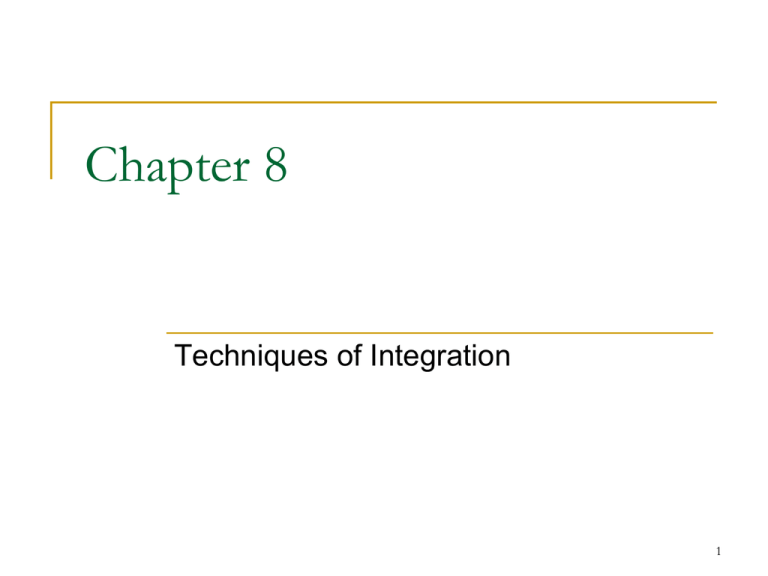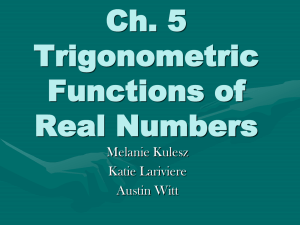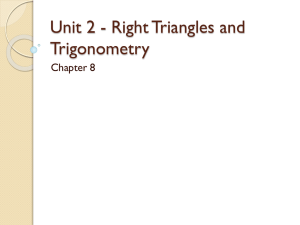Chapter08
advertisement

Chapter 8 Techniques of Integration 1 8.1 Basic Integration Formulas 2 3 Example 1 Making a simplifying substitution u 2x 9 dx d ( x 2 9 x) 2 x 9x 1 x 9x 1 du d (u 1) dv 2v1/ 2 C u 1 u 1 v 2 2(u 1) 1/ 2 C 2 x 9 x 1 2 1/ 2 C 4 Example 2 Completing the square dx 8x x 2 dx 16 ( x 4) d ( x 4) 16 ( x 4) 2 2 du 42 u 2 u x4 sin 1 C sin 1 C 4 4 5 Example 3 Expanding a power and using a trigonometric identity 2 (sec x tan x ) dx (sec 2 x tan 2 x 2sec x tan x)dx. d d 2 Racall:tan x sec x 1; tan x sec x; sec x tan x sec x; dx dx 2 2 (2sec 2 x 1 2sec x tan x)dx 2 tan x x 2sec x C 6 Example 4 Eliminating a square root /4 1 cos 4xdx 0 cos 4 x cos 2(2 x) 2cos 2 (2 x) 1 /4 /4 1 cos 4 xdx 0 0 /4 2cos 2 2 xdx 2 | cos 2 x | x 0 /4 2 cos 2 xdx ... 0 7 Example 5 Reducing an improper fraction 3x 2 7 x 3x 2 dx 6 x 3 dx 3x 2 2 x 3 dx x 2/3 1 2 2 x 3x 2ln | x | C 2 3 8 Example 6 Separating a fraction 3 3x 2 1 x x 2 dx dx 2 dx 1 x 1 x 1 d ( x2 ) 1 2 3 2 dx 1 x2 1 x2 3 du 2sin 1 x C 2 1 u 3 [2(1 u )1/ 2 ] 2sin 1 x C '' 2 2 2 du 1/ 2 2(1 u ) C' (1 u)1/ 2 3 (1 x 2 ) 2sin 1 x C '' 9 Example 7 Integral of y = sec x sec xdx ? d sec x sec x tan xdx d tan x sec xdx sec x sec xdx 2 d (sec x tan x) sec x(sec x tan x)dx d (sec x tan x) sec xdx sec x tan x d (sec x tan x) sec xdx sec x tan x ln | sec x tan x | C 10 11 12 8.2 Integration by Parts 13 Product rule in integral form d d d [ f ( x) g ( x)] g ( x) [ f ( x)] f ( x) [ g ( x)] dx dx dx d d d dx [ f ( x) g ( x)]dx g ( x) dx [ f ( x)]dx f ( x) dx [ g ( x)]dx f ( x) g ( x) g ( x) f '( x)dx f ( x) g '( x)dx Integration by parts formula 14 Alternative form of Eq. (1) We write dg x g x h x g x dx h x dx dx f x g x dx f x g x f x g x dx f x h x dx f x h x dx f x h x dx dx 15 Alternative form of the integration by parts formula d d d [ f ( x) g ( x)] g ( x) [ f ( x)] f ( x) [ g ( x)] dx dx dx d d d dx [ f ( x) g ( x)]dx g ( x) dx [ f ( x)]dx f ( x) dx [ g ( x)]dx f ( x) g ( x) g ( x)df ( x) f ( x)dg ( x) Let u f ( x); v g ( x).The above formular is recast into the form uv vdu udv 16 Example 4 Repeated use of integration by parts 2 x x e dx ? 17 Example 5 Solving for the unknown integral x e cos xdx ? 18 Evaluating by parts for definite integrals or, equivalently f x h x dx f x h x f x h x dx dx b b b a a a 19 Example 6 Finding area Find the area of the region in Figure 8.1 20 Solution 4 x xe dx ... 0 21 Example 9 Using a reduction formula Evaluate cos 3 xdx Use u cos n xdx cos n 1 dv x cos xdx cos n 1 x sin x n 1 n2 cos xdx n n 22 8.3 Integration of Rational Functions by Partial Fractions 23 General description of the method A rational function f(x)/g(x) can be written as a sum of partial fractions. To do so: (a) The degree of f(x) must be less than the degree of g(x). That is, the fraction must be proper. If it isn’t, divide f(x) by g(x) and work with the remainder term. We must know the factors of g(x). In theory, any polynomial with real coefficients can be written as a product of real linear factors and real quadratic factors. 24 Reducibility of a polynomial 1. 2. A polynomial is said to be reducible if it is the product of two polynomials of lower degree. A polynomial is irreducible if it is not the product of two polynomials of lower degree. THEOREM (Ayers, Schaum’s series, pg. 305) Consider a polynomial g(x) of order n ≥ 2 (with leading coefficient 1). Two possibilities: g(x) = (x-r) h1(x), where h1(x) is a polynomial of degree n-1, or g(x) = (x2+px+q) h2(x), where h2(x) is a polynomial of degree n-2, and (x2+px+q) is the irreducible quadratic factor. 25 Example g ( x) x 3 4 x ( x 2) x( x 2) linear factor poly. of degree 2 g ( x) x 3 4 x ( x 2 4) irreducible quadratic factor g ( x) x 4 9 ( x 2 3) irreducible quadratic factor x poly. of degree 1 ( x 3)( x 3) poly. or degree 2 g ( x) x 3 3x 2 x 3 ( x 1) ( x 2) 2 linear factor poly. or degree 2 26 Quadratic polynomial A quadratic polynomial (polynomial or order n = 2) is either reducible or not reducible. Consider: g(x)= x2+px+q. If (p2-4q) ≥ 0, g(x) is reducible, i.e. g(x) = (x+r1)(x+r2). If (p2-4q) < 0, g(x) is irreducible. 27 In general, a polynomial of degree n can always be expressed as the product of linear factors and irreducible quadratic factors: Pn ( x) ( x r1 ) n1 ( x r2 ) n2 ...( x rl ) nl ( x 2 p1 x q1 ) m1 ( x 2 p2 x q2 ) m2 ...( x 2 pk x qk ) mk n (n1 n2 ... nl ) 2(m1 m2 ... ml ) 28 Integration of rational functions by partial fractions 29 Example 1 Distinct linear factors x2 4 x 1 ( x 1)( x 1)( x 3) dx ... x2 4 x 1 A B C ... ( x 1)( x 1)( x 3) ( x 1) ( x 1) ( x 3) 30 Example 2 A repeated linear factor 6x 7 ( x 2)2 dx ... 6x 7 A B 2 ( x 2) ( x 2) ( x 2) 2 31 Example 3 Integrating an improper fraction 2 x3 4 x 2 x 3 x 2 2 x 3 dx ... 2 x3 4 x 2 x 3 5x 3 2x 2 2 x 2x 3 x 2x 3 5x 3 5x 3 A B ... 2 x 2 x 3 ( x 3)( x 1) ( x 3) ( x 1) 32 Example 4 Integrating with an irreducible quadratic factor in the denominator 2 x 4 ( x 2 1)( x 1)2 dx ... 2 x 4 Ax B C D 2 ... 2 2 2 ( x 1)( x 1) ( x 1) ( x 1) ( x 1) 33 Example 5 A repeated irreducible quadratic factor 1 x( x 2 1)2 dx ? 1 A Bx C Dx E 2 2 ... 2 2 2 x( x 1) x ( x 1) ( x 1) 34 Other ways to determine the coefficients Example 8 Using differentiation Find A, B and C in the equation x 1 A B C ( x 1)3 ( x 1) ( x 1) 2 ( x 1)3 A( x 1) 2 B ( x 1) C x 1 ( x 1)3 ( x 1)3 A( x 1) 2 B ( x 1) C x 1 x 1 C 2 A( x 1) 2 B ( x 1) x 1 A( x 1) B 1 d d [ A( x 1) B] (1) 0 dx dx A0 B 1 35 Example 9 Assigning numerical values to x Find A, B and C in x2 1 ( x 1)( x 2)( x 3) A B C ( x 1) ( x 2) ( x 3) A( x 2)( x 3) B( x 1)( x 3) C ( x 1)( x 2) f ( x) x2 1 f (1) 2 A 12 1 2 A 1 f (2) B 22 1 5; B 5 f (3) 2C 32 1 10; C 5 36 8.4 Trigonometric Integrals 37 38 Example 1 m is odd sin 3 x cos x dx ? 2 sin x cos x dx sin x cos x d cos x (cos x 1)cos x d cos x (u 1)u du ... 3 2 2 2 2 2 2 2 39 Example 2 m is even and n is odd cos x 5 dx ? cos x dx cos x cosx dx cos x d sin x (1-sin x) d sin x 5 4 2 2 2 2 u (1-u 2 ) 2 du 1+u 4 2u 2 du ... 40 Example 3 m and n are both even cos x sin 2 cos x sin 2 4 4 x dx ? x dx 2 1-cos2x 1+cos2x dx 2 2 1 2 1-cos2x 1+cos2x dx 4 1 1 cos 2 2 x cos 2 x cos 3 2 x dx ... 4 41 Example 6 Integrals of powers of tan x and sec x 3 sec xdx ? Use integration by parts. 3 2 sec xdx sec x sec xdx ; u dv dv sec 2 xdx v sec 2 xdx tan x u sec x du sec x tan xdx 2 sec x sec xdx u dv sec x tan x tan x sec x tan xdx (tan x sec x) dx tan x sec x (sec x tan x sec 2 x) dx tan x sec x d (sec x tan x) tan x sec x ln | sec x tan x | C sec xdx sec x du sec x tan x tan 2 x sec xdx sec x tan x (sec 2 x 1)sec xdx 3 3 sec xdx sec x tan x sec xdx sec xdx... 42 Example 7 Products of sines and cosines cos5 x sin 3xdx ? 1 cos(m n) x cos(m n) x ; 2 1 sin mx cos nx sin( m n) x sin( m n) x ; 2 1 cos mx cos nx cos( m n) x cos( m n) x 2 sin mx sin nx cos5x sin 3xdx 1 [sin(2 x) sin8 x]dx 2 ... 43 8.5 Trigonometric Substitutions 44 Three basic substitutions Useful for integrals involving a2 x2 , a2 x2 , x2 a2 45 Example 1 Using the substitution x=atanq dx 4 x 2 ? x 2tan y dx 2sec2 ydy 2(tan 2 y 1)dy dx 4 4 tan y 2 (tan 2 y 1) 1 tan 2 y 2(tan 2 y 1) 4 4 tan y 2 dy dy sec 2 ydy | sec y | dy ln | sec y tan y | C 46 Example 2 Using the substitution x = asinq x 2 dx 9 x 2 ? x 3sin y dx 3cos y dy x 2 dx 9 x 9 2 9sin 2 y 3cos y dy 9 9sin y 2 sin 2 y cos y dy 1 sin 2 y 9 sin 2 ydy ... 47 Example 3 Using the substitution x = asecq dx 25 x 4 2 ? 2 2 x sec y dx sec y tan y dy 5 5 dx 2 sec y tan y dy 1 sec y tan y dy 2 2 25 x 4 5 4sec y 4 5 sec 2 y 1 1 sec y tan y dy 1 sec y dy 2 5 5 sec y 1 1 ln | sec y tan y | C ... 5 48 Example 4 Finding the volume of a solid of revolution 2 V 16 0 dx x 2 4 2 ? 49 Solution 2 V 16 0 dx x 2 4 2 ? Let x 2tan y dx 2sec2 ydy V /4 0 2 2sec2 ydy tan 2 y 1 2 /4 0 2sec 2 ydy sec y 2 2 /4 cos 2 ydy ... 0 50 8.6 Integral Tables 51 Integral tables is provided at the back of Thomas’ T-4 A brief tables of integrals Integration can be evaluated using the tables of integral. 52 53 54 55 56 57 8.8 Improper Integrals 58 59 Infinite limits of integration A(a) lim A(b) lim 2 2e b b b / 2 2 b A(b) e x / 2dx ... 2 2eb / 2 0 60 61 Example 1 Evaluating an improper integral on [1,∞] Is the area under the curve y=(ln x)/x2 from 1 to ∞ finite? If so, what is it? b ln x lim 2 dx ? b x 1 62 Solution b b ln b ln x dx ln x u 1 x x 1 x d (ln x) ln1 eu du ln b ln b u u u e du u ( e ) 0 ue dw u 0 ln b w ln b e u ln b 0 du ue ;u ln x, x eu (e u ) du 0 w u 0 ln b e u ln b 0 0 1 1 ln b e ln b (e ln b 1) ln b 1 b b ln x 1 1 lim 2 dx lim ln b 1 1 b b x b b 1 b 63 Example 2 Evaluating an integral on [-∞,∞] dx 1 x2 ? 0 b dx dx dx lim 2 1 x 2 lim b b 1 x 2 1 x b 0 b dx 2lim 2 b 1 x 0 64 Solution Using the integral table (Eq. 16) dx 1 1 x a2 x2 a tan a C b b dx 1 1 1 1 tan x tan b tan 0 tan b . 0 1 x 2 0 dx 1 tan b 2 1 x2 2lim b 2 b y 1 y tan 1 b b tan y lim tan 1 b b 2 65 66 Example 3 Integrands with vertical asymptotes 67 Example 4 A divergent improper integral Investigate the convergence of 1 dx 0 1 x 68 Solution 1 b dx dx b lim ln | x 1|0 0 1 x blim 1 b 1 1 x 0 lim ln | b 1| ln | 0 1| b 1 lim ln | b 1| ln | 0 1| lim ln | b 1|1 b 1 b 1 1 lim ln 0 69 Example 5 Vertical asymptote at an interior point dx ( x 1) ? 3 2/3 0 70 Example 5 Vertical asymptote at an interior point dx dx dx 3 0 1 ( x 1) 2 / 3 1 0 3 ( x 1) 2 / 3 1 ( x 1) 2 / 3 b dx dx 1/ 3 b lim 3( x 1) 2/3 0 ( x 1)2 / 3 blim 0 1 ( x 1) b 1 0 lim 3(b 1)1/ 3 3( 1)1/ 3 lim 0 3 3; b 1 3 b 1 3 dx dx 1/ 3 3 lim 3( x 1) 1 ( x 1)2 / 3 clim c 1 ( x 1) 2 / 3 c 1 c lim 3(3 1)1/ 3 3(c 1)1/ 3 3 22 / 3 c 1 3 dx 2/3 3(1 2 ) 2/3 ( x 1) 0 71 Example 7 Finding the volume of an infinite solid The cross section of the solid in Figure 8.24 perpendicular to the x-axis are circular disks with diameters reaching from the xaxis to the curve y = ex, -∞ < x < ln 2. Find the volume of the horn. 72 Example 7 Finding the volume of an infinite solid volume of a slice of disk of thickness dx,diameter y V 1 V dV lim 4 b 0 1 lim 4 b ln 2 2 y ( x ) dx dV ( y / 2)2 dx b ln 2 2x e dx b 1 2 x ln 2 lim e b 8 b 1 lim 4 e 2b 8 b 1 2b lim (4 e ) 8 b 2 y dx 73







